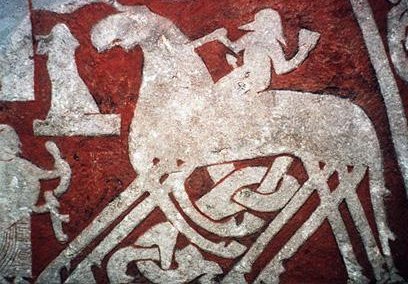
Detail of Odin riding Sleipnir from the Tjängvide image stone, Viking culture of Sweden, c. 700-1100 CE, Swedish Museum of National Antiquities, Stockholm .
Yuletide began as a German Nordic winter festival. The four Nordic seasonal festivals are Yuletide (December 22), Ostara (March 20), Sommersonnenwende (June 20), and Harvest (September 22). Yuletide was celebrated on December 22nd, the winter solstice (the shortest day/longest night of the year). The name “Yule” (Jul) comes from Jólner, one of the many names for the German god Woden (Odin). In the early 4th century, the Catholic Church decided Christmas would be celebrated on December 25, which is a date suspiciously very close to the winter solstice. The Yuletide celebration, which lasted for twelve days, became known as the twelve days of Christmas. And this is how Yuletide was gradually absorbed into the festival of Christmas.

Before Scandinavia was Christianized, Odin reigned supreme as the chief god of the Norse Pantheon, associated with war, wisdom, death and poetry. On Yule, a pagan (according to Christianity, of course) winter solstice celebration, Odin would lead a wild hunt through the sky while riding his eight-legged horse, Sleipnir. It is said that children would place their shoes near the chimney filled with carrots, straw or sugar for Sleipnir to eat. In the morning, they would find that Odin had replaced the food with gifts or candy, a reward for the childrens’ kindness.
Sound familiar? Like the modern tradition of leaving food and drink for Santa and his flying reindeer on Christmas, and waking up in the morning to find stockings filled with gifts? It is possible that through the years the god Odin became Saint Nicholas (in fact, Historian Margaret Baker claims the appearance of Santa Claus or Father Christmas, whose day is 25th of December, owes much to Odin, the old blue-hooded, cloaked, white-bearded Giftbringer of the north, who rode the midwinter sky on his eight-footed steed Sleipnir, visiting his people with gifts), Sleipnir became a team of reindeer, and ancient germanic pagan practices live on when we hang stockings by the fireplace on Christmas Eve, waiting them to be filled as a reward for our kindness.

There is only one thing i don't quite understand. I thought Santa was not Christian.. So maybe it is just that americans used the story of Saint Nicolas from the Greek, and those from Yuletide from the German?
ResponderEliminar